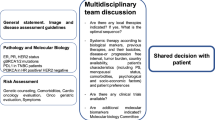Abstract
A useful prognostic factor in breast cancer has key roles, including identification of a group of patients whose prognosis is so good they do not require further treatment, such as adjuvant systemic therapy, after local surgery, and secondly a group with a poor prognosis for whom additional treatment would be appropriate. To be of clinical use, prognostic factors must show a wide separation in the outcome of the groups identified and select adequate numbers in each group. No single prognostic factor in invasive carcinoma of the breast satisfies all these criteria. However, the Nottingham prognostic index (NPI), which combines nodal status, tumour size and histological grade, does satisfy these criteria. The NPI has been validated by further studies in Nottingham and by studies in several other countries. Predictive factors, such as oestrogen receptor and HER-2 status, predict whether a tumour is likely to respond to a treatment, and are complimentary to prognostic factors. The NPI can be used in combination with predictive factors to select patients for systemic adjuvant treatments. There is the potential to improve the NPI by inclusion of other factors, such as vascular invasion, but any such alterations would require further validation.
Similar content being viewed by others
Abbreviations
- NPI:
-
Nottingham Prognostic Index
References
Clark GM, Hilsenbeck SG, Ravdin PM, De Laurentis M, Osborne CK (1994) Prognostic factors: rationale and methods of analysis and integration. Breast Cancer Res Treat 32:105–112
Blamey RW (1996) The design and clinical use of the Nottingham Prognostic Index in breast cancer. Breast 5:156–157
Fisher B, Bauer M, Wickerham DL, Redmond CK, Fisher ER (1983) Relation of number of positive axillary nodes to the prognosis of patients with primary breast cancer. An NSABP update. Cancer 52:1551–1557
Carter CL, Allen C, Henson DE (1989) Relation of tumor size, lymph node status, and survival in 24,740 breast cancer cases. Cancer 63:181–187
International Union Against Cancer (2002) Breast tumours. In: Sobin LH, Wittekind C (Eds) TNM classification of malignant tumours. Wiley, Geneva
Millis RR, Springall R, Lee AHS, Ryder K, Rytina ERC, Fentiman IS (2002) Occult axillary lymph node metastases are of no prognostic significance in breast cancer. Br J Cancer 86:396–401
Elston CW, Ellis IO (1991) Pathological prognostic factors in breast cancer. I. The value of histological grade in breast cancer: experience from a large study with long-term follow-up. Histopathology 19:403–410
Haybittle JL, Blamey RW, Elston CW et al (1982) A prognostic index in primary breast cancer. Br J Cancer 45:361–366
Balslev I, Axelsson CK, Zedeler K, Rasmussen BB, Carstensen B, Mouridsen HT (1994) The Nottingham Prognostic Index applied to 9,149 patients from the studies of the Danish Breast Cancer Cooperative Group (DBCG). Breast Cancer Res Treat 32:281–290
Brown JM, Benson EA, Jones M (1993) Confirmation of a long-term prognostic index for breast cancer. Breast 2:144–147
Sundquist M, Thorstenson S, Brudin L, Nordenskjold B, South East Swedish Breast Cancer Study Group (1999) Applying the Nottingham Prognostic Index to a Swedish breast cancer population. Breast Cancer Res Treat 53:1–8
Blamey RW, Ellis IO, Pinder SE et al (2007) Survival of invasive breast cancer according to the Nottingham Prognostic Index in cases diagnosed in 1990–1999. Eur J Cancer 43:1548–1555
van de Vijver MJ, He YD, van't Veer LJ et al (2002) A gene-expression signature as a predictor of survival in breast cancer. New Engl J Med 347:1999–2009
Abd El-Rehim DM, Ball G, Pinder SE et al (2005) High-throughput protein expression analysis using tissue microarray technology of a large well-characterised series identifies biologically distinct classes of breast cancer confirming recent cDNA expression analyses. Int J Cancer 116:340–350
Blamey RW, Mitchell MJ, Ball GR et al (2007) Prognostic estimation: re-analysis of data from cases diagnosed in 1990–99 by Cox proportional hazards model. Eur J Cancer Suppl 5(3):28
de Mascarel I, Bonichon F, Durand M et al (1998) Obvious peritumoral emboli: an elusive prognostic factor reappraised. Multivariate analysis of 1320 node-negative breast cancers. Eur J Cancer 34:58–65
Lee AHS, Pinder SE, Macmillan RD et al (2006) Prognostic value of lymphovascular invasion in women with lymph node negative invasive breast carcinoma. Eur J Cancer 42:357–362
Acknowledgement
We thank the European Journal of Cancer for permission to reproduce the data shown in Table 1 from reference 12.
Author information
Authors and Affiliations
Corresponding author
Rights and permissions
About this article
Cite this article
Lee, A.H.S., Ellis, I.O. The Nottingham Prognostic Index for Invasive Carcinoma of the Breast. Pathol. Oncol. Res. 14, 113–115 (2008). https://doi.org/10.1007/s12253-008-9067-3
Received:
Accepted:
Published:
Issue Date:
DOI: https://doi.org/10.1007/s12253-008-9067-3




